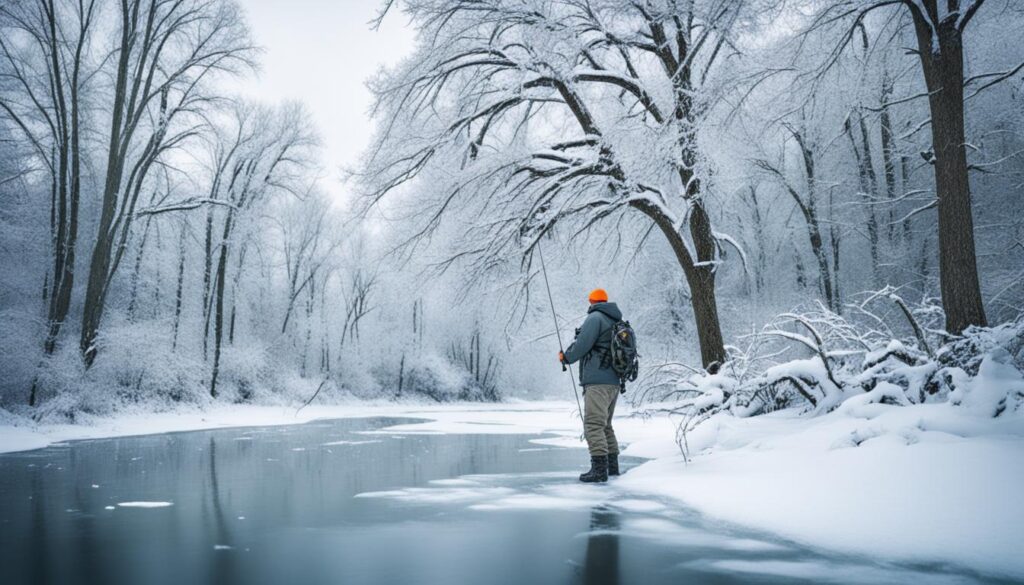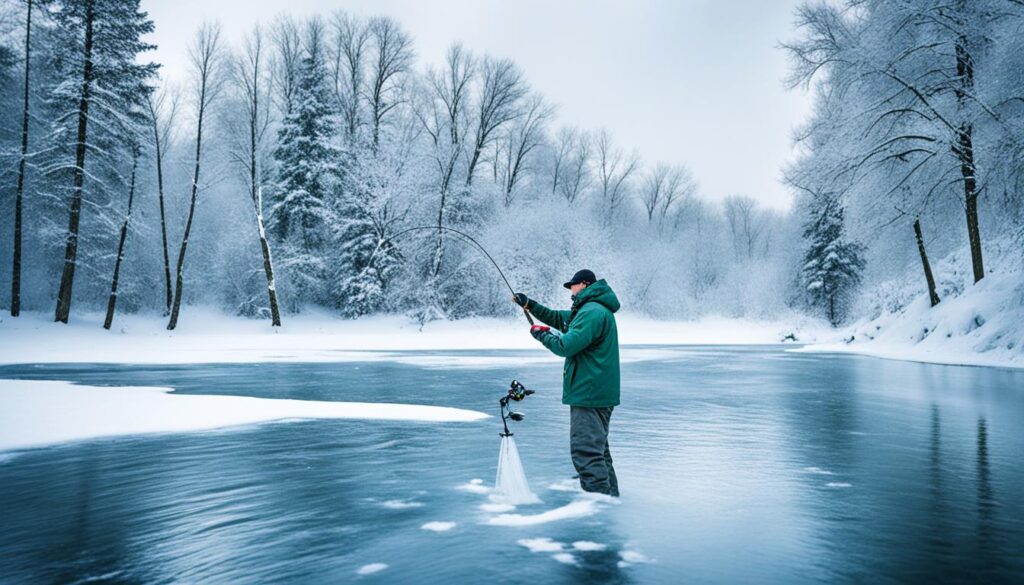Are you gearing up for some cold water chatterbait bass fishing tactics? You’ve come to the right place. In this article, I’ll share some expert tips and techniques to help you maximize your success when using a chatterbait in cold water conditions.
Angler’s Essentials
- Slowing down your presentation and keeping the bait close to the bottom can increase your chances of triggering a reaction strike in cold water.
- Selecting the right chatterbait trailer, such as a straight-tail trailer, can enhance the bait’s hunting action and maintain a natural movement in the strike zone.
- Pay close attention to technique and equipment, such as watching the line closely and using a lower gear ratio reel, to maximize the potential of the chatterbait in cold water.
- Chatterbait fishing is not limited to cold water conditions; it can be effective every season with different techniques and presentations.
- Winter, spring, summer, and fall each offer unique opportunities for chatterbait fishing, so adapt your approach accordingly.
The Importance of Fishing Slow in Cold Water
When water temperatures are at their lowest, it is crucial to fish slowly. Whether using a spinnerbait, chatterbait, or crankbait, slowing down your presentation and keeping the bait close to the bottom can increase your chances of triggering a reaction strike. By bumping into various cover forms, you can entice bass to strike even in cold water conditions.
Why Fish Slow in Cold Water?
Cold water changes the behavior of bass. They become less active and conserve energy to survive in the cooler temperatures. To get them to bite, you need to present your lure in a manner that appears enticing but not too fast or aggressive.
Remember, bass are creatures of habit, and they prefer an easy meal when the water is cold. A slow-moving bait that resembles an easy snack is more likely to get attention.
Choosing the Right Technique
One effective technique for fishing slowly in cold water is the bottom-bouncing method. This involves casting your bait and allowing it to sink to the bottom. Slowly retrieve it once it reaches the bottom, ensuring it stays close to the bottom throughout the retrieve.
Another technique is the slow roll retrieve. This is commonly used when fishing with spinnerbaits and chatterbaits. The key is to reel your bait at a plodding speed, allowing it to move seductively through the water. The slow roll retrieve mimics the movements of injured or weakened prey, making it irresistible to bass.
The Benefits of Fishing Slow
When you fish slowly in cold water, you let your bait spend more time in the strike zone. This increases your chances of getting a bite, as bass may be less willing to chase fast-moving lures in cold water. Additionally, fishing slowly allows you to cover an area thoroughly, increasing the likelihood of encountering hungry bass.
| Fishing Slow in Cold Water | Benefits |
|---|---|
| Slowing down your presentation | Increases chances of triggering a reaction strike |
| Keeping bait close to the bottom | Mimics easy prey and entices bass to strike |
| Fishing with a slow roll retrieve | Mimics injured or weakened prey |
| Prolonged time in the strike zone | Increases likelihood of getting a bite |
| Covering more area | Encounters more hungry bass |

Selecting the Right ChatterBait Trailer
When it comes to cold water fishing, choosing the right chatterbait trailer can make all the difference in your success. The trailer you select will determine the bait’s action and presentation in the water, enticing more bites from the bass. Let’s explore the key factors to consider when choosing the best chatterbait for cold water and how to use chatterbaits effectively in these conditions.
A straight-tail trailer is highly recommended for cold-water fishing with chatter baits. This type of trailer allows the bait to hunt more, creating erratic movements that trigger more bites from a bass. The natural swimming action of a straight-tail trailer closely imitates the movement of baitfish, making it an enticing target for predatory fish.
Additionally, straight-tail trailers help the chatterbait stay more profound in the water column, ensuring it remains in the strike zone for longer. As bass tend to be more lethargic in colder temperatures, having the bait at the correct depth is crucial for enticing strikes. The natural movement of the bait with a straight-tail trailer mimics the actions of injured or dying baitfish, which can trigger a reactionary bite response from a bass.
By selecting the best chatterbait trailer for cold water fishing, you can significantly enhance the effectiveness of your presentation and increase your chances of catching bass. Remember, the key is to replicate the natural movements and actions of baitfish to entice the predator’s attention.
| Benefits of Straight-Tail Trailers for Cold Water ChatterBait Fishing |
|---|
| Creates erratic movements that trigger more bites |
| Allows the bait to stay deeper in the water column |
| Maintains a natural movement in the strike zone |
| Imitates the actions of injured or dying baitfish |
ChatterBait Technique and Equipment
To maximize the potential of the chatterbait in cold water, it is essential to pay close attention to technique and equipment. Here are some effective chatterbait fishing tips for winter and the right equipment to enhance your cold-water bass fishing experience:
- Watch the line closely: Subtle movements can indicate a bite.
- Use a slower retrieval rate: Bass prefer slower-moving bait in cold water.
- Experiment with retrieves: Mix up your retrieve to trigger strikes.
- Adjust trailer size and color: Use smaller, natural-colored trailers.
- Pay attention to water depth: Adjust the weight for deeper waters.
By understanding the versatility of the chatterbait and using the right equipment, such as a reel with a lower gear ratio and appropriate trailers, you can improve your success rates in cold water conditions and increase your chances of landing that elusive bass.

My Favorite ChatterBait Setup
| Equipment | Details |
|---|---|
| Rod | 7′ Medium-Heavy Casting Rod |
| Reel | 6.3:1 Gear Ratio Baitcaster |
| Line | 12-15 lb fluorocarbon |
| ChatterBait | 3/8 oz bluegill pattern |
| Trailer | 3.5″ straight-tail grub (green pumpkin) |
Chatterbait Fishing: Year-Round Success
Chatterbait fishing is a versatile technique that is effective every season, providing anglers with year-round bass-catching opportunities. Mastering seasonal techniques and presentations can significantly enhance your success.
Winter Chatterbait Fishing
- Behavior: Bass are lazy and less active.
- Technique: Use a slow, steady retrieve to mimic wounded baitfish.
- Target Areas: Offshore structures like points and drop-offs.
Spring Chatterbait Fishing
- Behavior: Bass become more active and move to shallower areas.
- Technique: Slow roll retrieves in shallow areas with cover.
- Target Areas: Grass, vegetation, and fallen trees.
Summer Chatterbait Fishing
- Behavior: Bass spread out, seeking refuge in weed beds and submerged vegetation.
- Technique: Vary retrieve speed to mimic different baitfish behaviors.
- Target Areas: Docks, rocks, and vegetation.
Fall Chatterbait Fishing
- Behavior: Bass enters a feeding frenzy, preparing for winter.
- Technique: Fast, aggressive retrieve with occasional pauses and twitches.
- Target Areas: Vegetation such as grass mats and lily pads.
Tips for Year-Round Chatterbait Success
- Adapt to Conditions: Adjust techniques and presentations to seasonal bass behavior.
- Versatility: The chatterbait’s unique action makes it effective year-round.
By tailoring your approach to each season’s specific conditions and bass behavior, you can optimize your chances of success with a chatterbait throughout the year.

Conclusion
Chatterbait fishing is a year-round technique that can adapt to the changing behavior of bass in different seasons. By understanding and applying seasonal strategies, anglers can significantly improve their chances of catching bass regardless of the time of year. Whether it’s the slow, steady retrieve needed in winter, the active targeting of shallow covers in spring, the varied retrieves in summer, or the fast, aggressive approach in fall, mastering these techniques can lead to successful fishing outings. The chatterbait’s versatility and unique action make it an indispensable tool for any bass angler looking to maximize their catches throughout the year.
